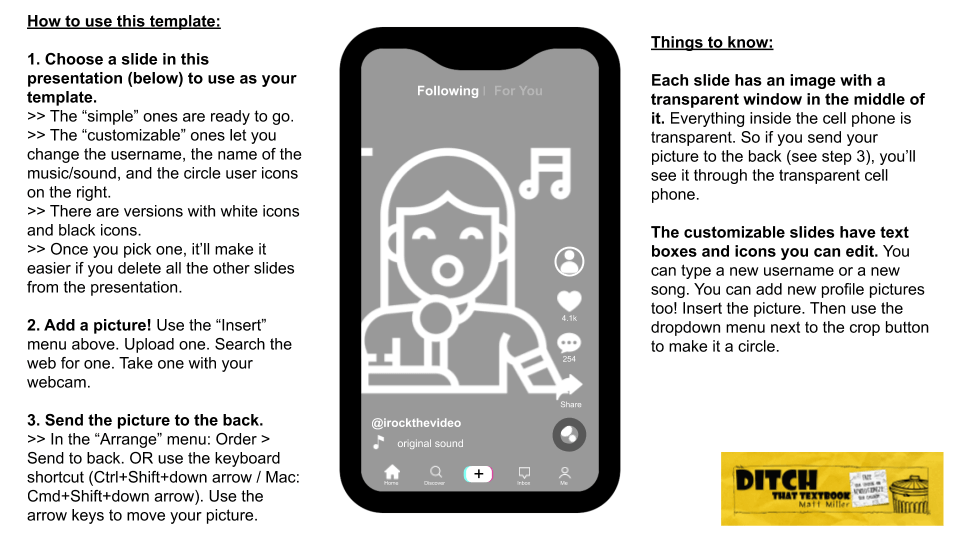
This post is written by Lindsay Zilly. Lindsay is the Director of Professional Learning for Illinois Digital Educators Alliance. She is a Google Certified Educator, Apple Learning Specialist, Microsoft Innovative Educator, Seesaw Ambassador and Apple Teacher 2016. Follow Lindsay on Twitter and Instagram: @iCoachLindsay
As a lifelong learner, we have to be open to learning new things every day. If you subscribe to this way of thinking, you might also agree that learning takes place everywhere. Let’s take a look at some incredible resources, tools and strategies I learned from a very unlikely place: Tik Tok.
As they say: if you can't beat em, join em!

I am from the generation of My Space and Live Journal. If you know, you know. If those terms seem foreign to you, never fear. One day you too will identify as the Gram Generation and feel your age as heavy as I do now.
The point is, my social media experience came through a dial up connection, screeching computer screen and, if the stars aligned, a male computer voice, greeting me with “You’ve Got Mail”. Things have changed significantly since my AIM days but no matter what, the premise behind social media has always stayed true to form: we login to connect with others. So I evolved with social media; from Facebook to Twitter. Snap Chat to Instagram, to where I am today: Tik Tok.
Allow me the opportunity to attempt to get you to reconsider any preconceived negative notions associated with Tik Tok.
I believe there are several different Tik Tok identities:
- The head shakers. Nope, nope, so much nope.
- The fencers. Those who are not yet sold on even the idea of Tik Tok and are afraid to download the app itself.
- The lurkers (present!) Lurking through content to escape the day or find a quick laugh.
- The toe dippers. You are ready to get started using it and get a rush from posting that first video.
- All in. Making the Tiks. Dancing to the Toks and speaking the language.
No matter where you fall in your Tik Tok identity, I believe there is something to be gained from this app. Consider this: If you were to have your own Tik Tok series what would it be called?
- Or perhaps, think of it this way instead: What is your personal impact statement?
As an educational content creator, I think it is important to leverage universal learning standards in the work I do and the experiences I create. Therefore, I regularly use the ISTE standards as a baseline for the instructional practices I share. The standards that fit my work with Tik Tok are no exception and are as follows:
- Educators continually improve their practice by learning from and with others and exploring proven and promising practices that leverage technology to improve student learning.
- Use technology to create, adapt and personalize learning experiences that foster independent learning and accommodate learner differences and needs.
Or simply put,
The Micro PD We Never Knew We Needed
So, how can we teachers benefit from Tik Tok? Sometimes being a teacher feels like you are all alone in your silo.

Sure, the typical teaching experience is one where you are surrounded by other classrooms and maybe you even visit the teachers lounge from time to time. But once you close your classroom door, or log onto your individual Zoom session and it’s just you and your kids, that time can feel very isolating. It’s important for teachers to remember that we aren’t alone. The work we are doing is monumentally important and that there are so many other educators experiencing the same things we are at this very moment.
Using Tik Tok to seek out other educators that help you see you are not alone is necessary. These people, brave enough to throw open their classroom doors and share the good, the bad and the ugly are our life preservers. A few of these lifeguards that create some incredible content on Tik Tok and who you should follow today are listed here: bit.ly/TikTokDoc21 Feel free to add some of your favorite follows as well!
Tik Tok in the Classroom? How Dare I?!
Bringing Tik Tok into our classrooms is a big deal and because of this it requires careful consideration and planning. But the benefits far outweigh the drawbacks. You may ask, how can we get used to the idea of using Tik Tok, or anything that is trending for that matter to capitalize on teachable moments? First, we have to see this as a means of connecting with our learners. I’m sure you have countless “getting to know you” activities or ways you develop relationships with your students. Leveraging Tik Tok is just one more way to do this, but I would argue, it is on a whole other level than your average ice breaker.
There are trends associated with everything. Fashion, social media, education. Most of these trends are cyclical and pop back up again years after their original popularity. Take Kagan Strategies for example. Isn’t that just the method formerly known as cooperative learning strategies? Everything seems to come back around again and social media is no different. But, for us to be able to use this to our advantage, we must first consider the reasons why Tik Tok is so successful. This brings me to what I like to call, the Tik Tok Method.
The Tik Tok Method
- High Interest Topics
- Engaging Presenters
- Short, consumable VIDEO content
- Few words/Word Choice
- Entertaining
Believe it or not, this method was adapted from an article I read about how to go viral on Tik Tok. You see, micro PD is everywhere; it just all depends on the lens you choose to look at it through. We are surrounded by teachable moments and life is so much better when we embrace them. But, I’m sure you are wondering how to embrace or at least employ the Tik Tok Method when it comes to teaching your students. I have a few thoughts to help get you started.
Theory: Tik Tok is essentially flipped learning
Enhanced Communication
There are 5 things that Tik Tok promotes that we as educators could afford to take notes on. See if you agree with me.
The content creators on any social media platform are generally using video content or high resolution graphic art to capture the attention of an audience not present at the time of the recording. The goal is, once they create this content and share it out, it will gain them a multitude of views and in turn new followers.
So, why not use this strategy to our advantage in the classroom? This is essentially instructing students on how to do something or sharing information with them on a new topic when we are not providing them direct instruction. Maybe a year ago we would have shied away from the idea of making videos for our students, but we are living in a whole new world now. Let’s look at applying some Tik Tok strategies to the video content we are creating for students.
The Tik Tok 5 Essentials
Kick off with a bang
Set the tone and topic of the video within the first few seconds so that people understand what they’re watching.
Short and sweet
Most screencasting tools have a time limit. You only get X minutes with the free version and while that may seem unfair, generally speaking that’s usually more than enough time. Consider this: would you rather be assigned a 5o minute long video to watch at a staff meeting or 5 10 minute videos? The shorter the video, the easier it is to pay attention too and the more you retain. Instead of recording yourself for 50 minutes, which can be nerve racking and very time consuming, record yourself in smaller chunks. It’s easier on you should you make a mistake or get interrupted, it’s easier for the consumer to watch and it’s differentiation. You can pinpoint where your students went wrong in a video series and have them go back to the exact location of their error. You can have higher achieving students skip certain videos. And it’s a resource for studying when it’s time for the summative assessment. You can’t beat, short and sweet!
Tell a story
The story can be anything. It can be something interesting that happened in your life, something random that happened during your day, a project you did, anything that connects to your content. Students are more likely to remember the content you share with them if you tell a story because they connect that content to the personal piece of information you shared.
Have a call to action
It’s great to have a call to action in your caption and/or at the end of your video such as “like for part 2”, “follow for more”, or “don’t let this flop”. But that doesn’t exactly make sense for teachers. Instead, ask a question not specific to the content. Then, do something with their answers! For example, ask your students to find out what their parents favorite song was when they were their age then make a playlist of all the classic oldies and start tomorrow’s class with it. Or have kids identify an item that was in the background of one of your videos. Get creative! This really helps turn Incomplete assignments to complete, submitted assignments.
Leave some questions unanswered
Make it so some of the aspects of the video need to be rewatched. If you’re posting a video and you can think of an obvious question people will have – DO NOT EXPLAIN IT. This is your accountability piece. It also promotes peer to peer feedback in the form of comments. Instead of thinking they can only go to you for answers, if you encourage them to comment on your videos, they will have an entire class to work through solutions with.
How do educators AND students benefit?
The Literal and the Theoretical Applications
As lifelong learners it’s our responsibility to continue our own education so that we are not teaching students our past but their future. In my opinion, there are two paths to take when considering implementing the Tik Tok Method into your practice. You can take a literal approach or a theoretical approach. No matter the approach you take, the goal is the same: apply the changes for the benefit of both the students AND the teacher.
Literal Approach
Take the literal idea of Tik Tok, the structure, the look and the feel of it and apply it to an educational standard. Matt Miller has created a wonderful template based on this idea. If I were to use this approach, I would have students focus on a given standard and create a 90 second video summary explaining the content. When creating their “post” students can reflect on an appropriate caption, attention getting title, relevant background music and then package it all up using Matt’s template to share out in a safe and controlled platform like Google Slides.
Theoretical Approach
The 4 C’s
I am a frequent flyer when it comes to the 4 C’s: creativity, communication, critical thinking and collaboration. I think they are relevant regardless of the content you teach or the level students you have. Therefore, I use these four pillars as a base for many lessons I create. Sometimes I focus on one, other times I strive to leverage multiple skills. Here’s a breakdown that I would use when considering the Tik Tok Method.
- Creativity: How can we hand the reigns over to students so that they have freedom to create on their own while being mindful of the learning targets?
- Communication: What alternatives to traditional assessment strategies can you allow students to engage in to show what they know? Think about what technologies you could use to get students talking to each other and in turn listening!
- Critical Thinking: If you pull apart the components of trending Tik Tok videos, what about them could students use to solve problems? Dancing? Recipes? Compare and contrast?
- Collaboration: Are your students connecting with one another and even more importantly to the content? How are you developing teamwork and collaboration outside of the classroom walls?
The End Beginning
As lifelong learners it’s our responsibility to continue our own education so that we are not teaching students our past but their future. Applying these ideas to both the students AND the teacher demonstrates this to students. If all goes well, an amazing thing can be achieved: FAME! Just kidding! (Unless you count schoolwide fame, that is.) The amazing thing that happens is that it strengthens student and teacher relationships. Students are seeing their teachers taking risks, being vulnerable and exploring new avenues of learning. This provides a safe place for them to do the same. Teachers are connecting with their learners in a way that can’t be unpacked in a learning target or shared through Google Classroom. Relationships matter. The best way to get your students on board with what they are learning is to meet them where they are at. Pretty soon, they will start taking ownership over their learning because they truly see the value in what you are teaching them. Can you imagine a time where students no longer ask, “why do we need to learn this?” As my friend JP will tell you,
So, what skills or learning targets can you teach using the Tik Tok Method? How about:
- Poetry
- Point of view
- Summarizing
- Narrative writing
- Steps of an equation
- Dialogue
Vibe Check
I’ll finish by asking you once more, what is your personal impact statement? How can trends help you accomplish your goals and learning targets this year? I hope I have helped you shift your mindset on Tik Tok or at the very least, I’ve put you onto something.
Some other trends have I played around with include:
For notifications of new Ditch That Textbook content and helpful links:
Are you looking for quality, meaningful professional learning that both equips and inspires teachers?
Matt provides in-person and virtual keynotes, workshops and breakout sessions that equip, inspire and encourage teachers to create change in their classrooms. Teachers leave with loads of resources. They participate. They laugh. They see tech use and teaching in a new light. Click the link below to contact us and learn how you can bring Matt to your school or district!
Is Matt presenting near you soon? Check out his upcoming live events!




